Tender, juicy pork slivers flavoured with an umami-rich sauce, Peking shredded pork is simple to cook but tastes absolutely amazing.
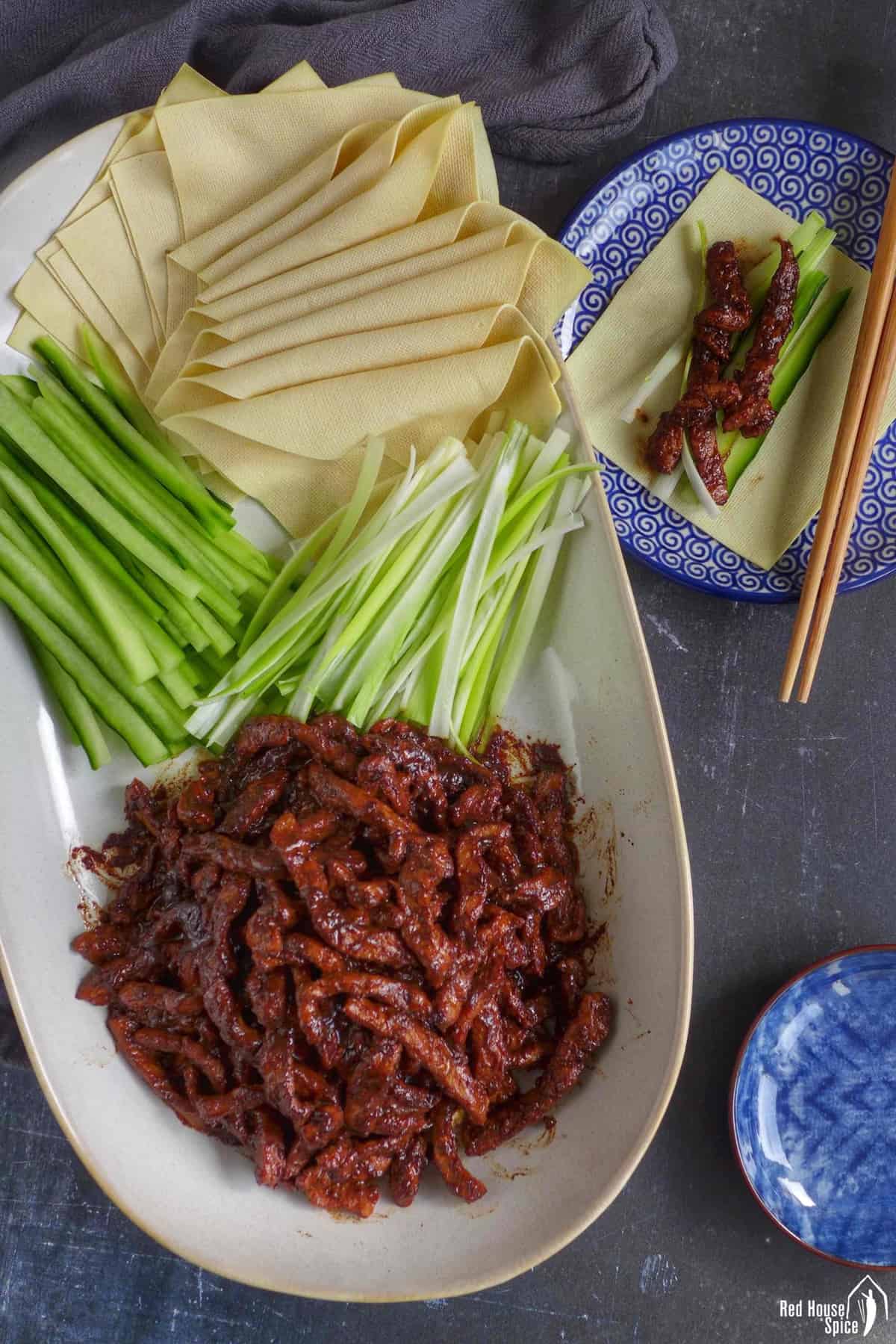
A classic Beijing dish
One of the key features of Beijing cuisine is the use of fermented sauces. Think Beijing fried sauce noodles (Zhan Jiang Mian) and the dark sauce served with slices of Peking duck. Today’s recipe Peking shredded pork is another classic example (*Peking is an older transliteration of the word for China’s capital city).
Jing Jiang Rou Si/京酱肉丝, the Chinese name of this dish, literally means “Peking sauce pork slivers”. They are lightly fried tender strips of pork coated with a salty-sweet, umami-rich brown sauce, and often wrapped in tofu sheets (or duck pancakes) along with julienned scallions and cucumber.
It’s a simple dish to make and surely a crowd-pleaser. Read on to learn tips and tricks to cook it to perfection.
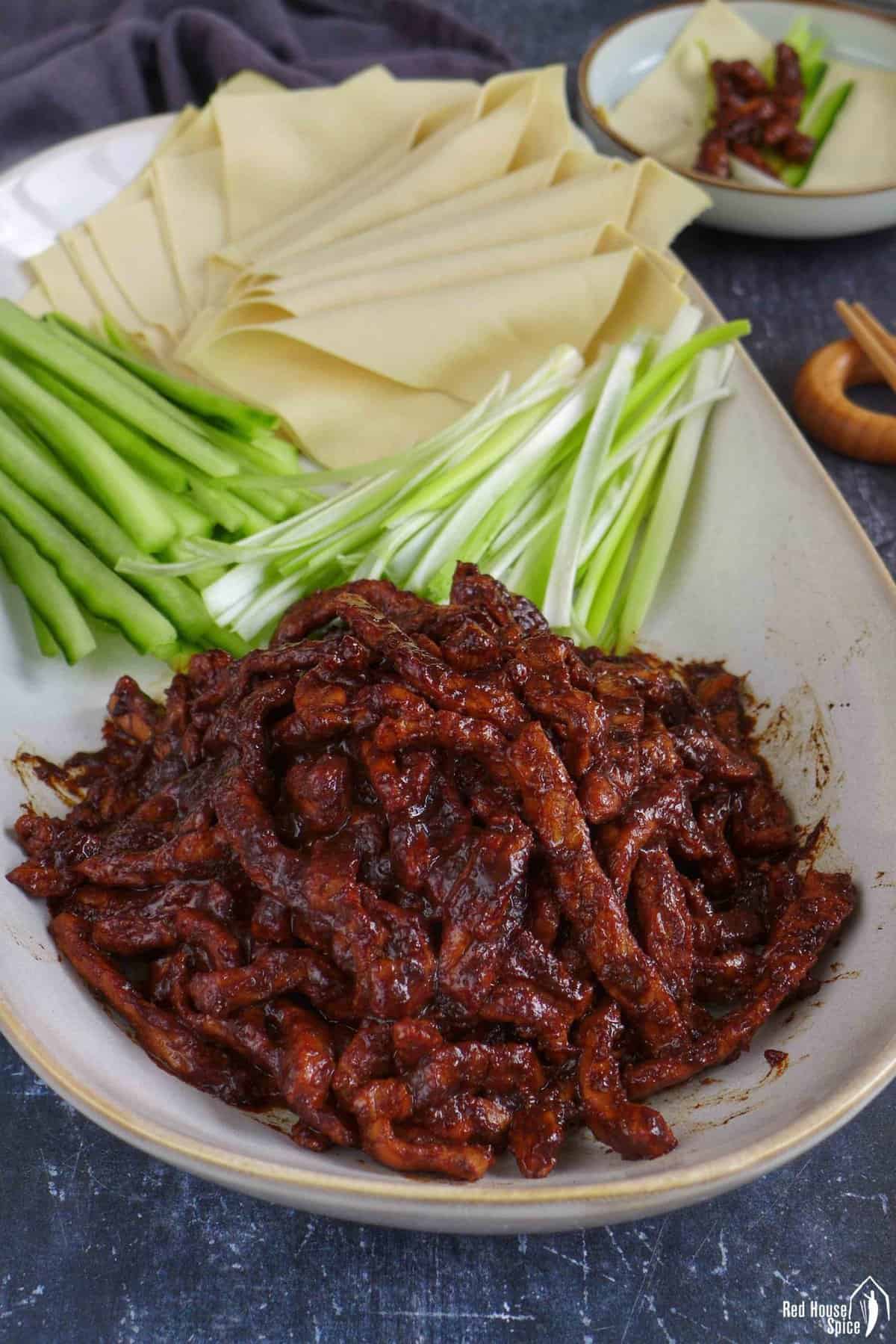
Choose and prepare the pork
A great plate of Peking shredded pork should taste very tender, not stringy or chewy. To achieve the ideal texture, let’s first talk about how to choose and prepare pork, the star ingredient of the dish.
Use pork tenderloin
Unlike many classic dishes that showcase Chinese’s love for fatty pork, such as Red Braised Pork Belly, Twice Cooked Pork, etc, today’s dish calls for the leanest cut of pork, tenderloin, aka pork fillet or pork tender.
Known as Li Ji Rou/里脊肉 in Chinese, tenderloin is a long, thin cut of pork that has a delicate flavour and tender texture. It’s perfect for quick wok stir-frying. Don’t confuse it with pork loin which is also lean but requires lengthy cooking to become tender.
How to cut the meat
Same as for Sichuan Shredded Pork with Garlic Sauce, you’ll need to cut the pork into long, thin strips. Some Chinese chefs suggest that each strip should resemble the narrow end of chopsticks.
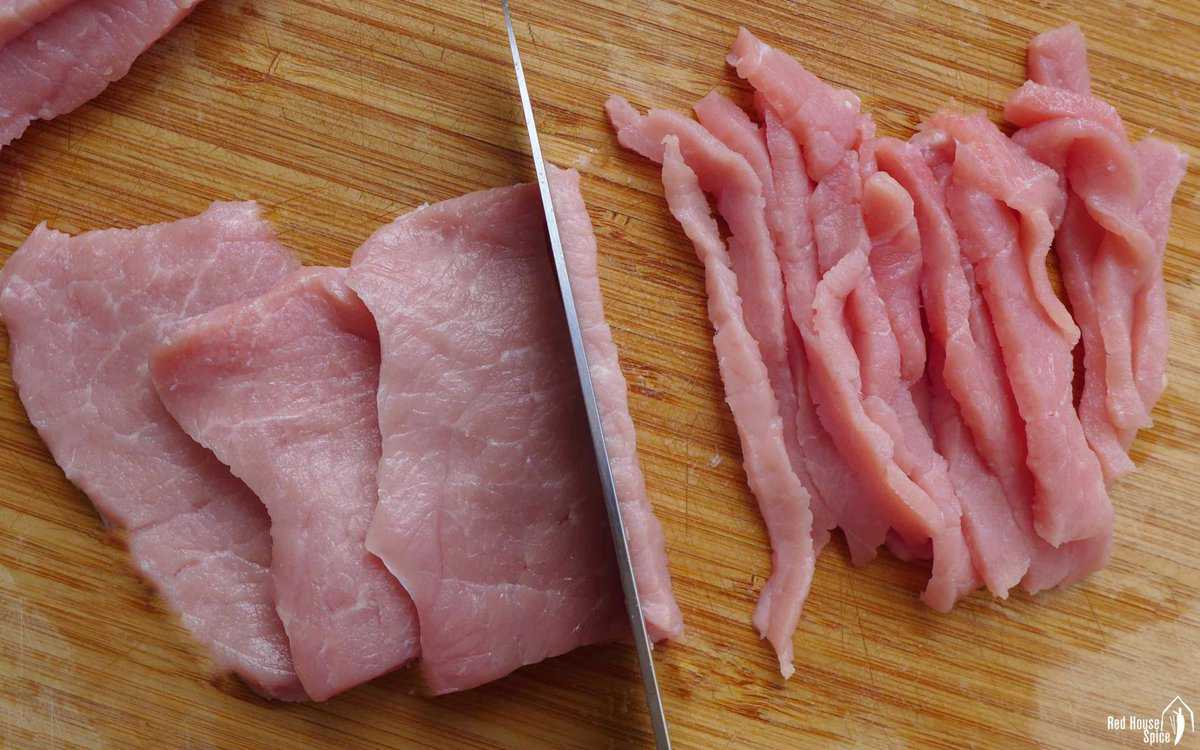
I admit that it takes some time to finish this task. But the following tips would help you accomplish it more efficiently.
- Sharpen your knife before cutting.
- Wet the knife with water to avoid sticking.
- Cut the pork across the grain. This is key to tenderness.
- If you find fresh meat too soft to manage, put it into the freezer for 1-2 hours until semi-frozen. It’ll become much easier to cut.
Marinate before cooking

Marinating is an important step for this dish. It’s a process of velveting the pork which leads to a desired tender texture after cooking. It also adds flavour to the meat. For 400g/14oz pork, you’d need the following to make the marinade:
- Salt, ¼ teaspoon
- Light soy sauce, 2 teaspoons
- Shaoxing rice wine, 2 teaspoons
- Cornstarch, 1 teaspoon
- White pepper, 1 pinch
- Water (or unsalted stock), 2 tablespoons
Put pork strips and all the ingredients above into a bowl. Use your fingers or chopsticks to agitate until no more liquid can be seen. At this moment, the meat should look and feel sticky. Finally, stir in a little oil to coat. Leave to marinate for at least 10 minutes.
Mix the sauce
A popular condiment of northern Chinese cuisine, sweet bean sauce is the key ingredient that gives the pork a dark brown coating and a rich umami taste. Called Tian Mian Jiang/甜面酱 in Chinese, it mainly comprises fermented wheat flour, with just a small portion of soybeans. That is why it’s also called sweet flour sauce, or sweet wheat sauce.
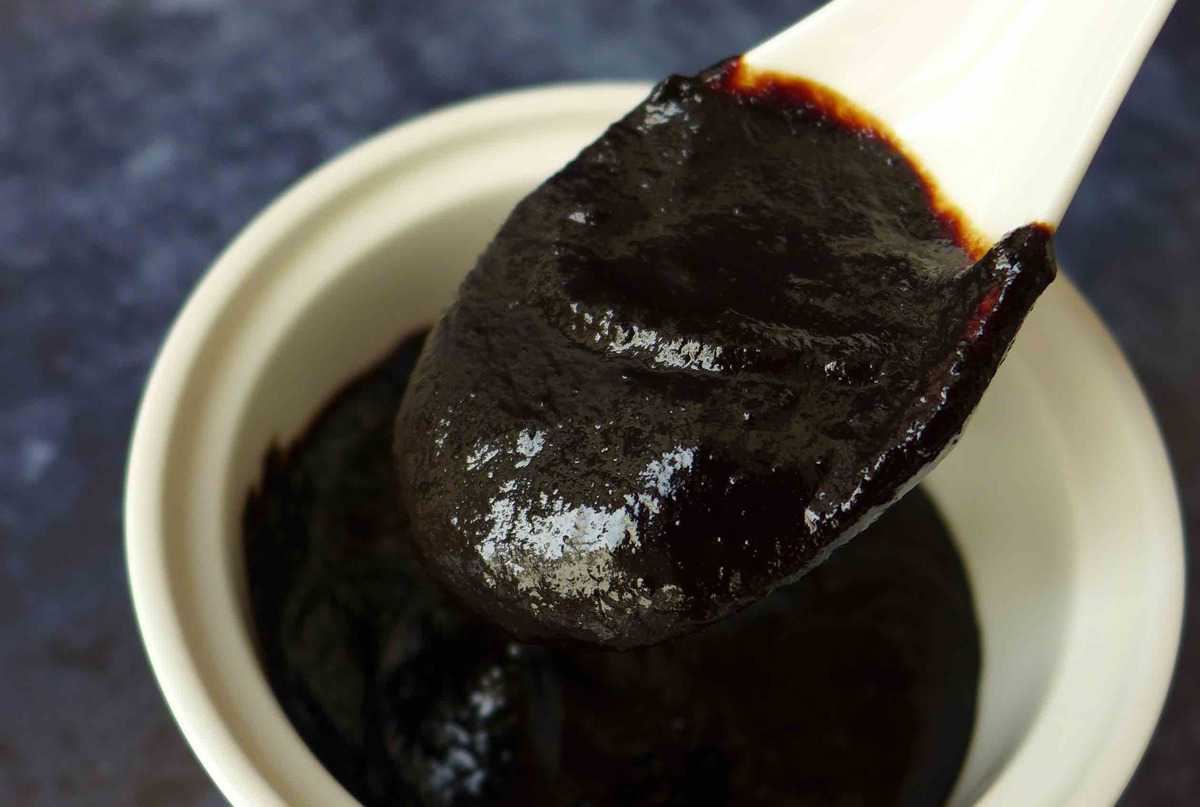
Although it has the word sweet in its name, this sauce doesn’t really have a strong sweet taste but a distinctive salty, sour flavour. So you’d need to balance it with a little sugar. Before cooking, dilute the sauce with some Shaoxing rice wine and water until it becomes runny and smooth.
🛎 SUBSTITUTES: If you have trouble sourcing sweet bean sauce, please feel free to replace it with either yellow soybean sauce (黄豆酱) or hoisin sauce (海鲜酱). If using the latter, you don’t need to add extra sugar as it tastes quite sweet on its own.
Cooking steps
Some traditional recipes suggest you deep fry the pork. For home cooking, I prefer using less oil when possible. So here is my alternative method:
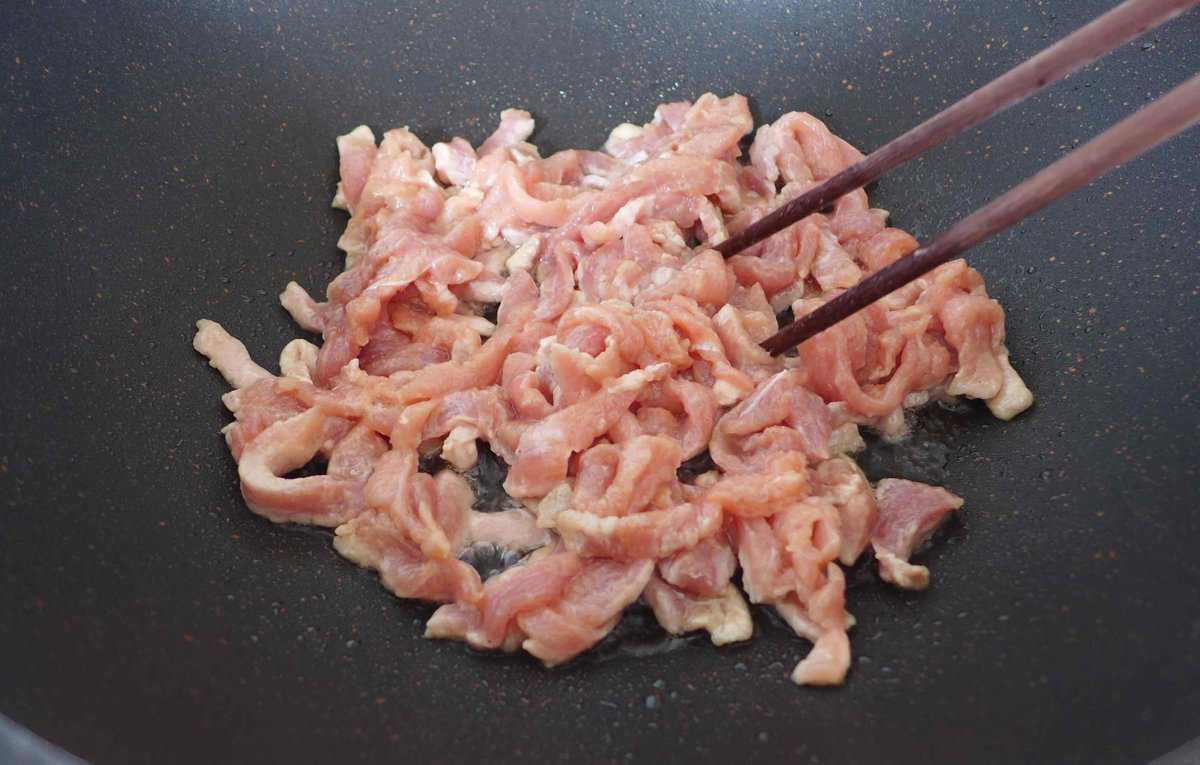
Heat a wok (or deep frying pan/skillet) over high heat until very hot then add 3 tablespoons of oil. Slide in the marinated pork. Use a pair of chopsticks to separate the strips. Then keep tossing to cook the pork quickly and evenly.
🛎 NOTE: If your cookware has a non-stick coating, remember to add the oil first then heat it.
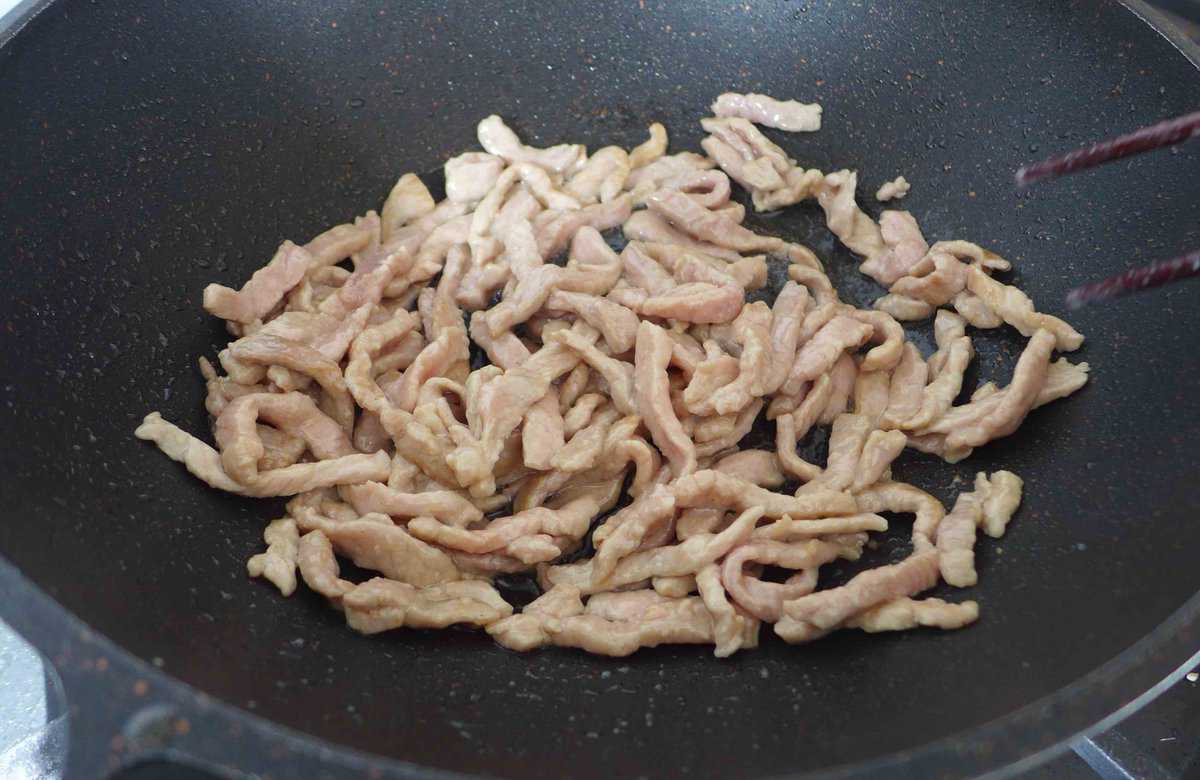
As soon as the meat loses its pink colour, dish out immediately leaving some oil in the wok. Since the pork strips are thin, they cook quickly. Resist the temptation to overcook.
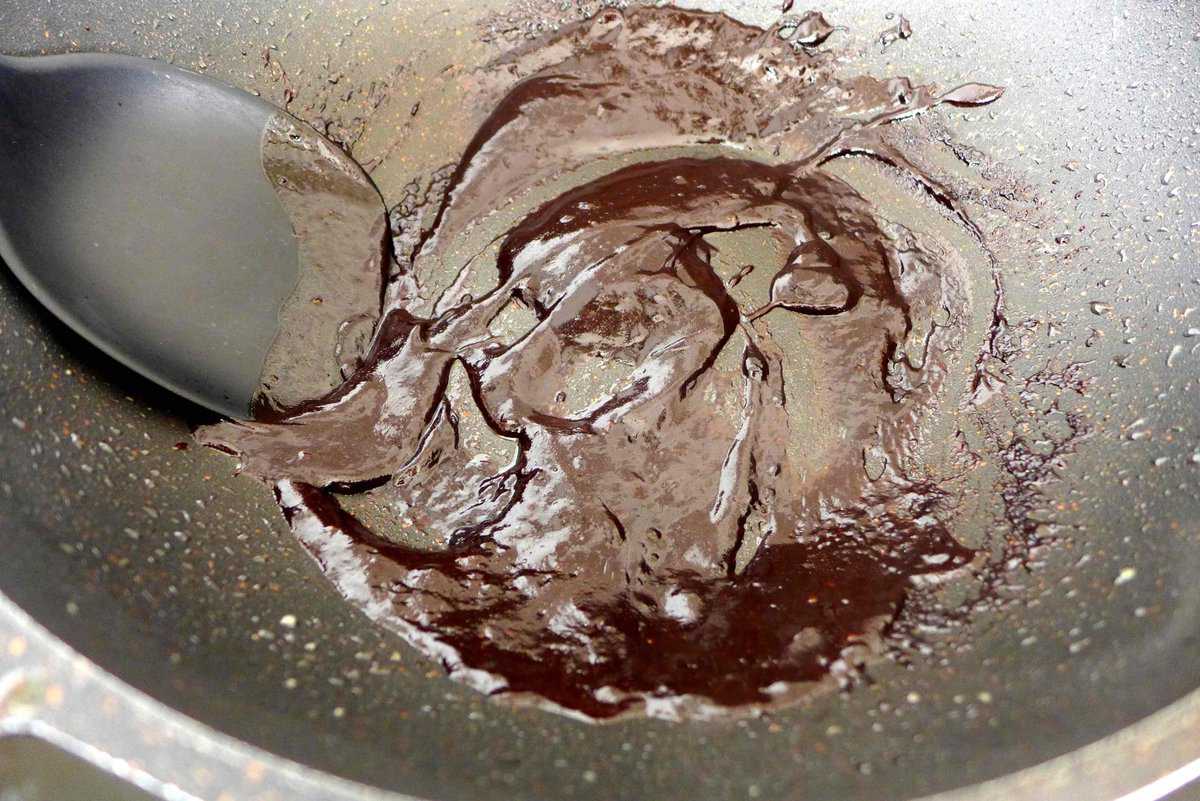
Turn the heat to the lowest then pour in the sauce mixture. Leave to simmer until it starts to thicken. Put the pork back in.
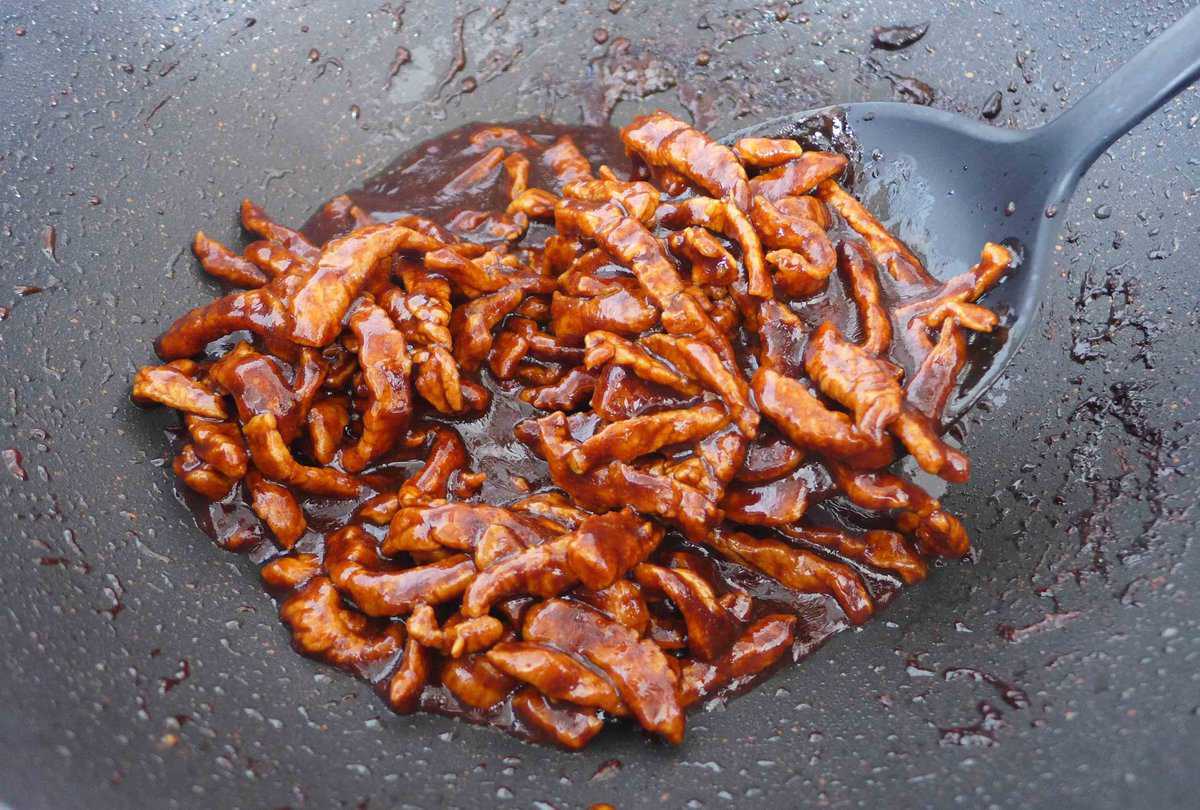
Toss quickly to evenly coat every pork strip with the sauce. Once the colour looks uniform, dish out to serve.
🛎 NOTE: Contrary to some recipes’ suggestions, you don’t need any starch to thicken the sauce thanks to the thick, sticky nature of sweet bean sauce.
How to serve
In Chinese restaurants, Peking shredded pork is often served in two ways: For the simple version, just place the saucy pork strips over a bed of thinly chopped scallions. The other way is as shown in the image below.
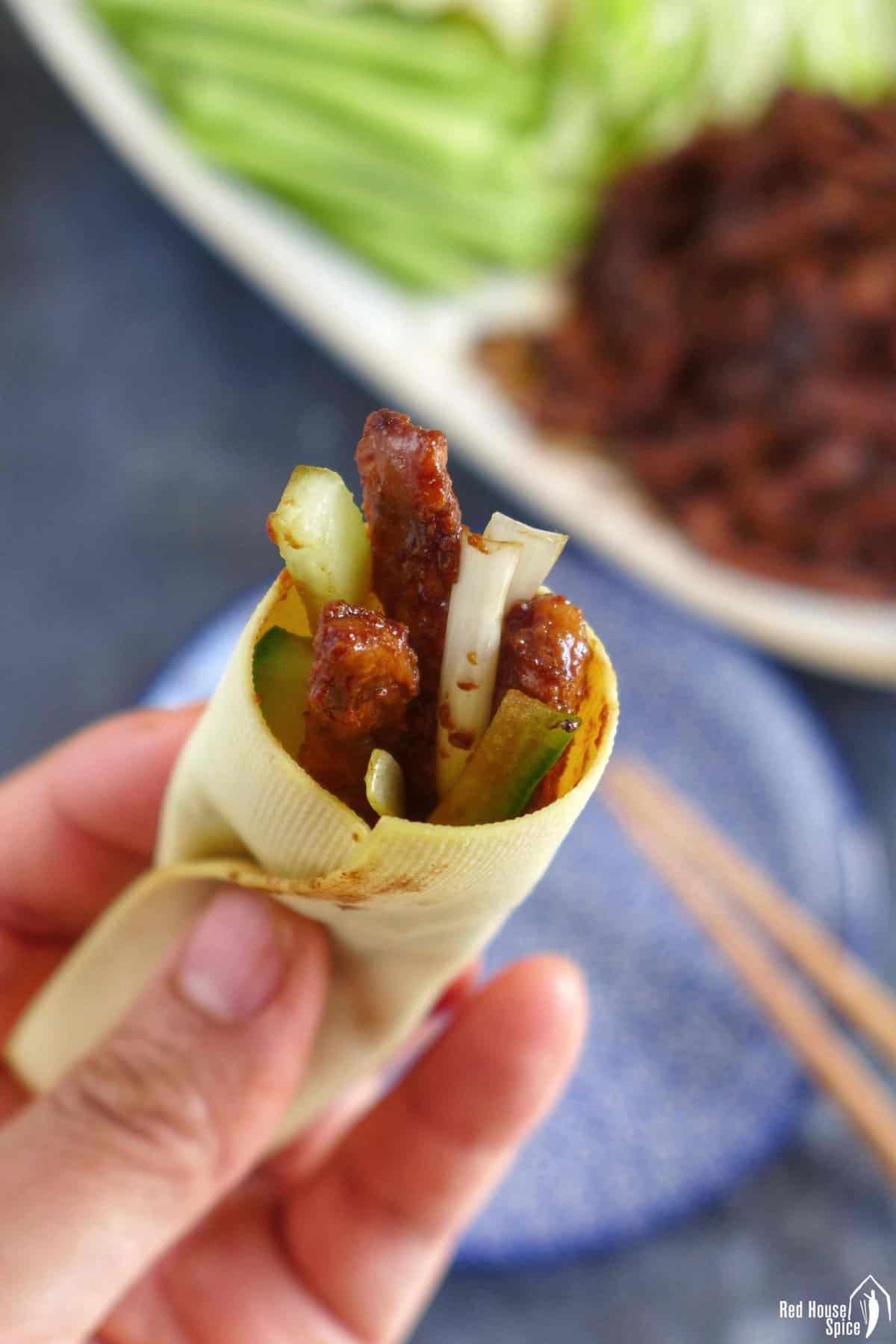
Wrap shreds of pork, along with julienned scallions and cucumber, with a piece of tofu sheet (aka paper tofu). It tastes so good this way with different textures and flavours in just one mouthful.
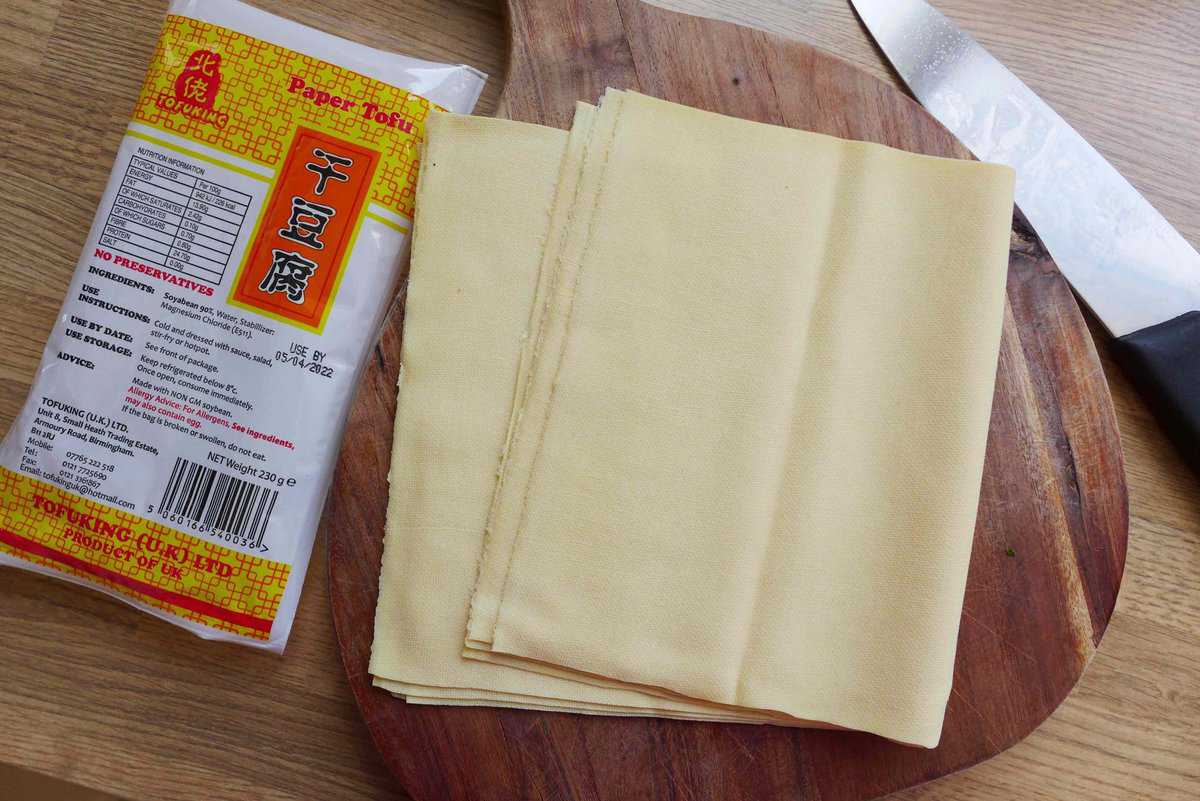
Unfamiliar with tofu sheets? They are pressed tofu in the form of a sheet. Pliable yet firm, they’re a versatile ingredient found in many dishes, such as stir-fries, soups, hot pot, etc.
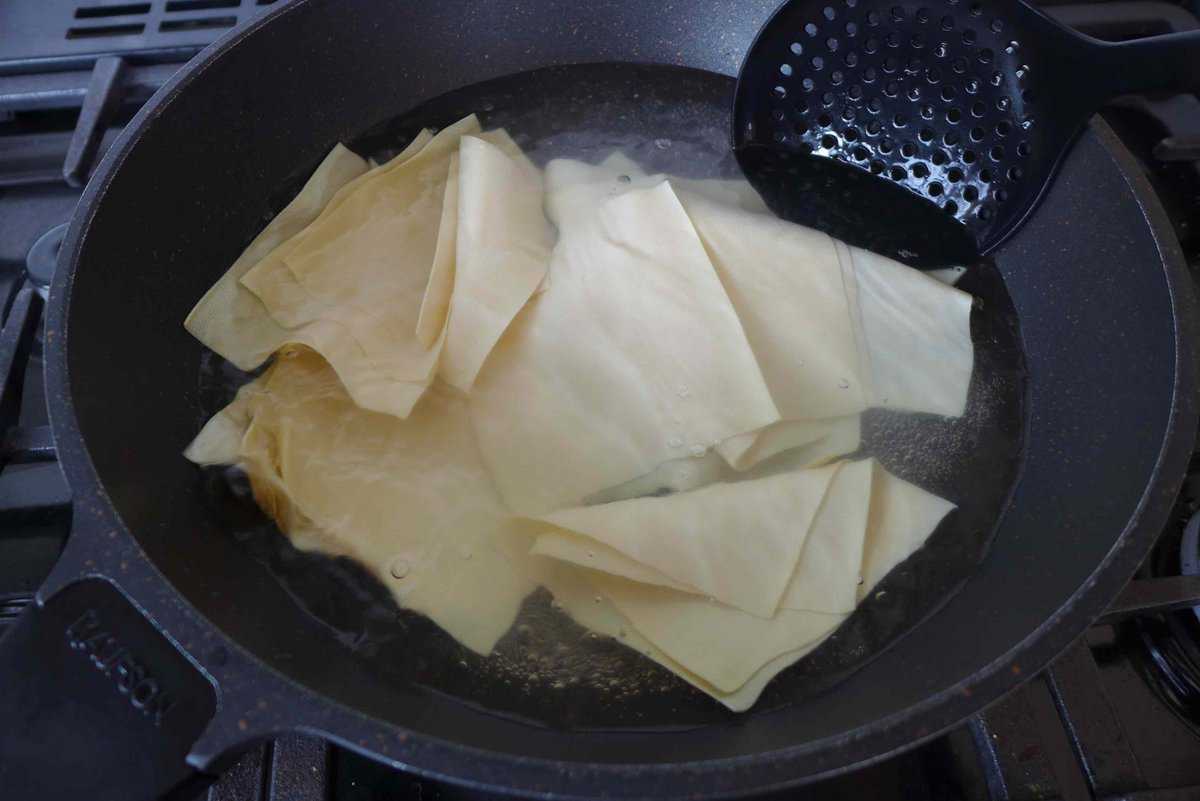
For this recipe, cut them into squares (similar to the size of a wonton wrapper) then briefly blanch them in boiling water.
If you can’t find tofu sheets, use shop-bought or homemade duck pancakes (aka moo shu wrappers) instead, just like how you enjoy the famous Peking duck! Steamed Bao Buns are a good alternative too.
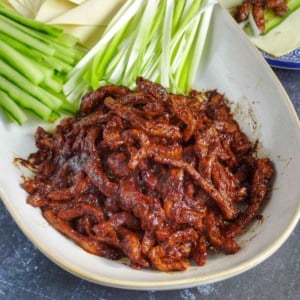
Peking Shredded Pork with Sweet Bean Sauce (京酱肉丝)
Ingredients
For marinating
- 400 g pork tenderloin (aka pork fillet) - about 14oz
- 2 teaspoon light soy sauce
- 2 teaspoon Shaoxing rice wine
- 1 teaspoon cornstarch
- ¼ teaspoon salt
- 1 pinch ground white pepper
- 2 tablespoon water
- 1 teaspoon neutral cooking oil
For the accompaniments
- Scallions, the white part only
- Cucumber
- Tofu sheets - or duck pancakes (see note 1 & 2)
For the sauce
- 3 tablespoon sweet bean sauce (Tian Mian Jiang/甜面酱) - see note 3
- 1 tablespoon Shaoxing rice wine
- 1 tablespoon sugar
- 2 tablespoon water
For stir-frying
- 3 tablespoon neutral cooking oil
Instructions
Marinate the pork
- Use a sharp knife, cut pork, across the grain, into narrow strips. Then put it into a bowl. Add light soy sauce, Shaoxing rice wine, cornstarch, salt, white pepper and water.
- Use your fingers or chopsticks to agitate until the liquid is fully absorbed and the meat becomes sticky. Pour in 1 teaspoon of oil and mix to coat. Leave to marinate for 10 minutes or so.
Prepare the accompaniments
- Julienne the white part of the scallions. Peel the cucumber and remove its seeds, then cut it into thin strips.
- Cut tofu sheets into squares (similar size to wonton wrappers). Blanch them in boiling water for 2 minutes. Drain then leave to dry.
Mix the sauce
- In a bowl, mix sweet bean sauce, Shaoxing rice wine, sugar and water until smooth. Set aside.
Stir-fry the dish
- Heat a wok (or a deep frying pan/skillet) until very hot then add 3 tablespoons of oil (if using non-stick cookware, add oil first then heat up).
- Put in the marinated pork. Use chopsticks to loosen the strips. Then toss constantly to fry evenly. As soon as the meat turns pale, transfer out leaving any oil in the wok.
- Turn the heat to low. Pour the sauce mixture into the wok and leave to simmer.
- Once the sauce starts to thicken, return the pork to the wok. Toss to evenly coat it with the sauce.
Serve the dish
- Transfer the pork to a serving plate and put tofu sheets, scallions and cucumber on the side.
- Place some scallions, cucumber and pork strips over a piece of tofu sheet. Roll up and enjoy!
NOTES
NUTRITION
NUTRITION DISCLOSURE: Nutritional information on this website is provided as a courtesy to readers. It should be considered estimates. Please use your own brand nutritional values or your preferred nutrition calculator to double check against our estimates.


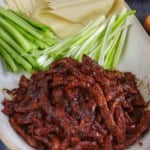



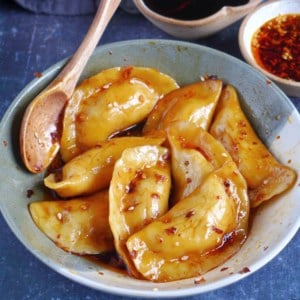
Your note about Peking’s name reminded me of an embarrassing moment. I was actually in a restaurant in Beijing, eating ‘Beijing Duck’ when I asked if that was similar to ‘Peking Duck’. It was only then that I found out I was IN Peking.
That’s a funny story but I know you’re not the only who made this mistake!